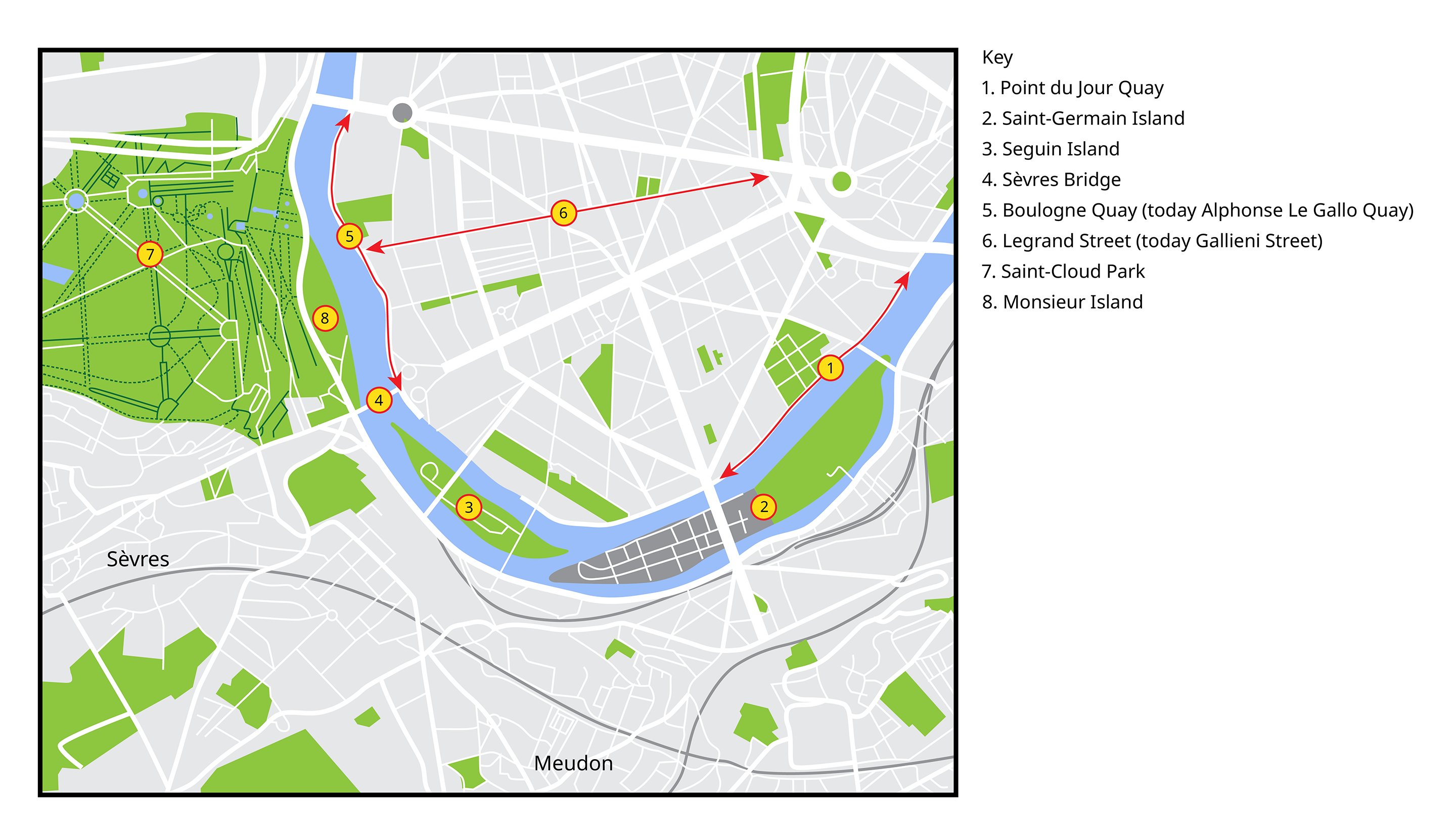Catalogue Entry
Citation
Chicago:
Brigid M. Boyle, “Alfred Sisley, The Embankment at Billancourt—Snow, ca. 1879,” catalogue entry in French Paintings and Pastels, 1600–1945: The Collections of The Nelson-Atkins Museum of Art, ed. Aimee Marcereau DeGalan (Kansas City: The Nelson-Atkins Museum of Art, 2023), https://doi.org/10.37764/78973.5.660.5407.
MLA:
Boyle, Brigid M. “Alfred Sisley, The Embankment at Billancourt—Snow, ca. 1879,” catalogue entry. French Paintings and Pastels, 1600–1945: The Collections of The Nelson-Atkins Museum of Art, edited by Aimee Marcereau DeGalan, Nelson-Atkins Museum of Art, 2023. doi: 10.37764/78973.5.660.5407.
Alfred Sisley painted The Embankment at Billancourt—Snow during a stretch of extreme economic hardship. The artist struggled to support his family throughout his career, but his period of residence in Sèvres (1877–80), a suburb of Paris, was particularly difficult. Paul Durand-Ruel, Sisley’s dealer and principal source of income, was also in dire straits during the late 1870s, and he stopped purchasing pictures from Sisley between 1876 and 1879. It was only in 1880, when banker Jules Feder provided Durand-Ruel with much-needed capital, that he began acquiring Sisley’s works again.1Caroline Durand-Ruel Godefroy, “Paul Durand-Ruel and Alfred Sisley: 1872–1895,” in MaryAnne Stevens, ed., Alfred Sisley, exh. cat. (London: Royal Academy of Arts, 1992), 36–38. Sisley’s grim financial prospects at this time find their visual corollary in this landscape, an austere winter scene with a muted palette of grays and browns. The composition is divided into two bands of roughly equal size: an overcast sky dominates the upper register, while days-old snow and opaque water fill the bottom one. Apart from Sisley, only a few brave souls have ventured outdoors. The men huddled at the water’s edge draw our eye thanks to the jagged diagonal extending from the bottom right corner to the horizon. Their raised arms suggest that they are signaling the boats offshore. Like Sisley, these figures keep working under harsh conditions.
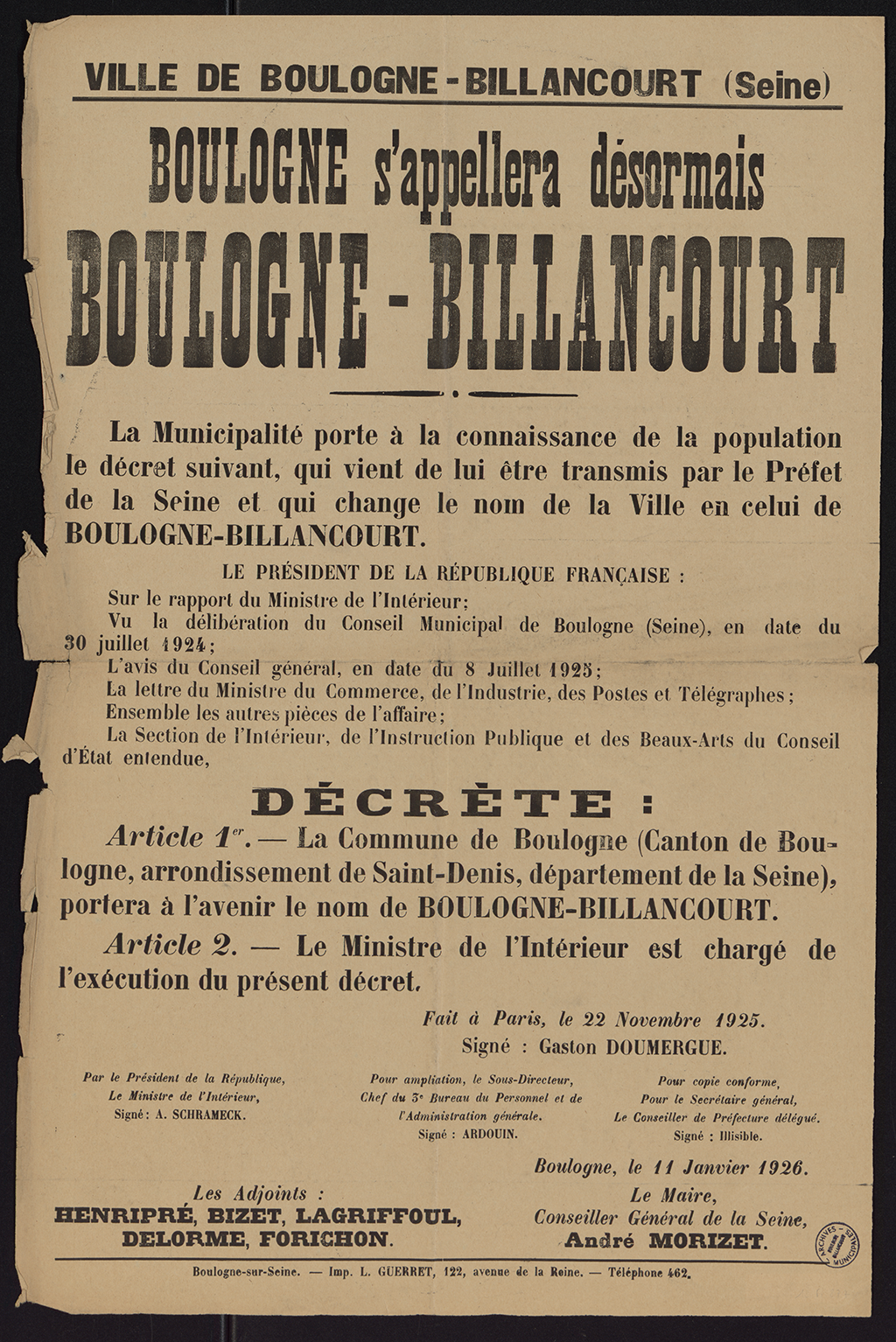
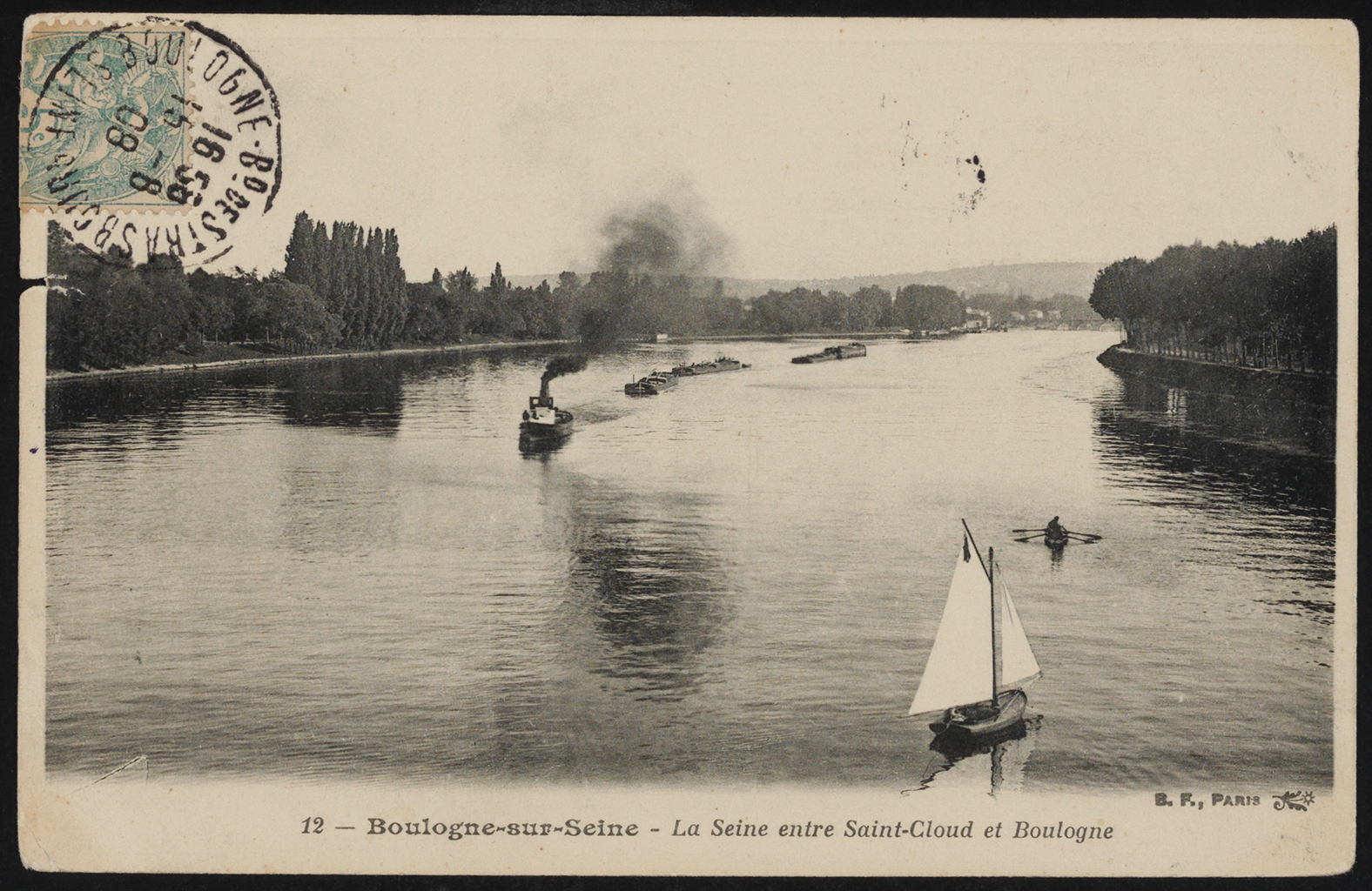
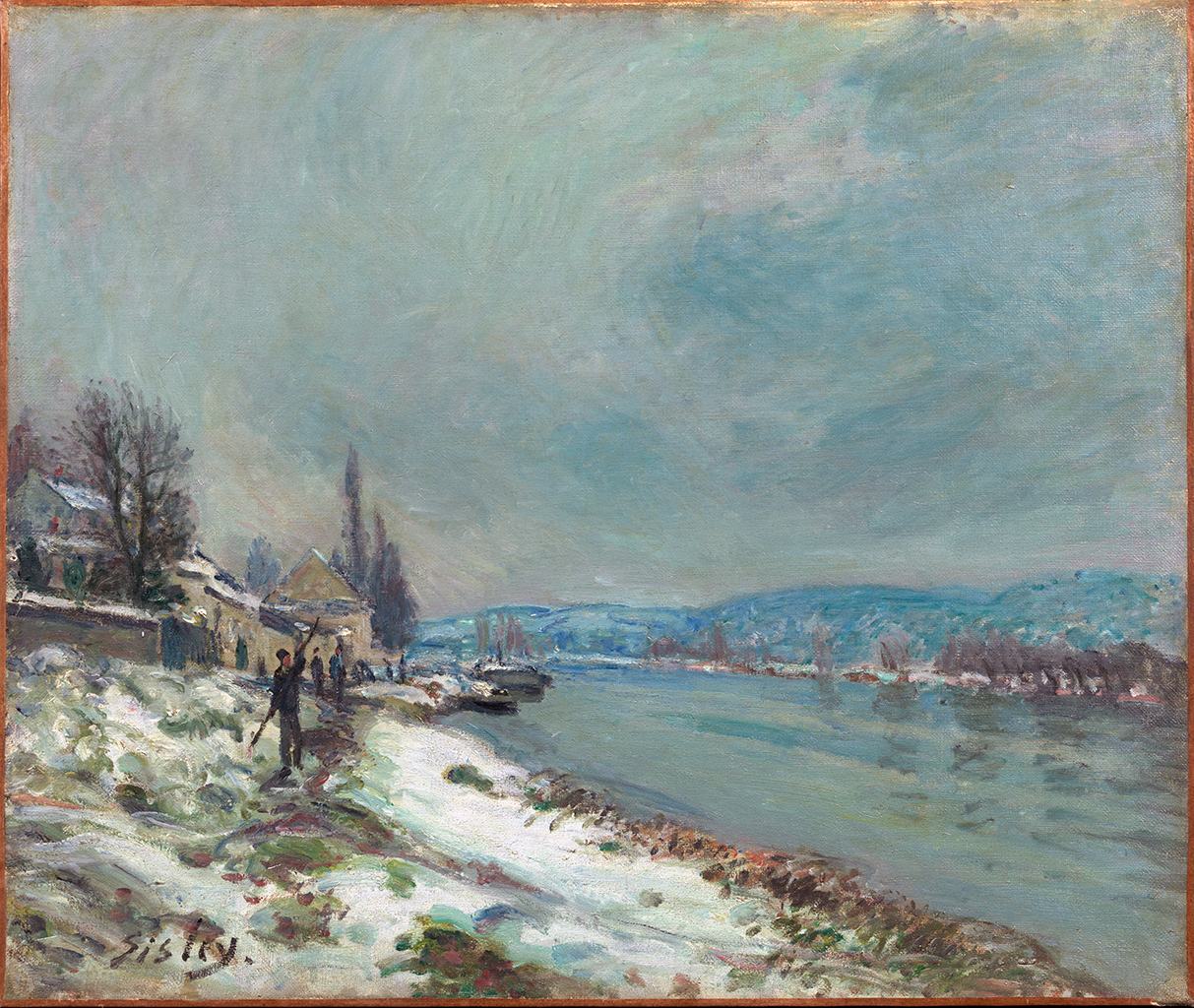
Both paintings caught the eye of Durand-Ruel, who acquired them within two years of one another—the Kansas City work in 1892 from French dealer Gaston-Alexandre Camentron (1862–1919) and the privately owned canvas in 1894 from the posthumous sale of French businessman Léon Clapisson.12For Clapisson’s life and career, see Anne Distel, “Léon Clapisson: Patron and Collector,” in Bailey, Renoir’s Portraits, 76–86. The former remained in Durand-Ruel’s possession for thirty-five years, initially at the firm’s Paris gallery (from 1892 to 1897) but later transferred to its New York branch (from 1897 to 1927). During this lengthy period of ownership, Durand-Ruel Galleries lent the picture to its competitor, Galerie Georges Petit, for an 1897 retrospective on Sisley and also mounted in-house exhibitions on the artist in 1917 and 1921, both of which included the Nelson-Atkins work.13The exhibitions in question were Exposition Alfred Sisley, Galerie Georges Petit, Paris, February 5–28, 1897; Exhibition: Paintings by Sisley (1840–1899), Durand-Ruel Galleries, New York, March 24–April 7, 1917; and Exhibition of Paintings by Alfred Sisley (1840–1899), Durand-Ruel Galleries, New York, January 8–22, 1921. These shows were well received. Several critics admired Sisley’s four-season approach; that is, his tendency to represent the same landscapes at different times of year. A visitor to the 1897 retrospective remarked: “I cannot express how much I love this sensitive and modest Sisley, among all the Impressionists, who is exhibiting some of his work at Petit’s. . . . In his paintings, he wishes only to bring to life the serene splendor of summer skies, the poignant melancholy of autumn skies, the innocent sweetness of spring skies, [and] the dreary sadness of winter skies.”14Montmirail, “Notes d’un badaud,” Le Gaulois, no. 5588 (February 20, 1897): 1. “Je ne saurais dire combien j’aime entre tous les impressionnistes ce délicat et simple Sisley qui expose chez Petit une partie de son œuvre. . . . Il ne souhaite que de faire revivre dans ses tableaux la sereine splendeur des ciels d’été, la mélancholie douloureuse des ciels d’automne, la douceur virginale des ciels de printemps, la morne tristesse des ciels d’hiver.” All translations are by Brigid M. Boyle. Twenty years later, when The Embankment at Billancourt—Snow was on display in New York, an American critic offered similar words of praise and singled out the Kansas City painting as emblematic of this trend:
[Sisley] loved best to picture with his facile brush, the smoothly flowing pellucid Seine and Loing, and the quiet little villages which nestle under their low banks—and to picture them at all seasons, in drowsy summer noontides, on spring mornings, in Indian summer, and again on still wintry days. Here, for example, is the bank at Billancourt on a late spring day, with its luscious greens, and the same scene on a calm winter morning, with soft snow over all.15“Exhibitions Now On: Sisley at Durand-Ruel’s,” American Art News 15, no. 25 (March 31, 1917): 2.
Both writers lauded Sisley as an astute observer of natural phenomena who excelled at painting the French countryside, no matter the season.
These exhibitions did not immediately yield a sale of The Embankment at Billancourt—Snow, but in 1927 Durand-Ruel at last found a buyer: Kansas City dealer Effie Seachrest (1869–1952). The daughter of a cattle farmer, Seachrest was an unlikely advocate for modern art. She studied for two years at the University of Chicago, intending to become a writer, and then continued her education at the Stacy Art School (today the Kansas City Art Institute).16For accounts of Seachrest’s life, see Madeleine Johnston, “Penpoint Portraits of Kansas City Women: Effie Seachrest, Art Advisor,” Kansas City Star, November 3, 1929, 7C; Edward R. Schauffler, “Taking Up Art For Art’s Sake: It Became Her Life Work,” Kansas City Star, July 14, 1946, 4C; “Miss Effie Seachrest: The Art Connoisseur and Collector Dies at 83,” Kansas City Times, March 24, 1952, 8; Donald L. Hoffmann, “Effie Seachrest, a Little Lady Who Brought Great Art Here,” Kansas City Star, August 28, 1966, 1E; Daniel MacMorris, “Artist Adds a Word Picture of Effie Seachrest,” Kansas City Star, September 17, 1966, 16; and Homage to Effie Seachrest, exh. cat. (Kansas City, MO: Nelson Gallery-Atkins Museum, 1966), 5–7. Unmarried, she supported herself by teaching third grade at a local elementary school but eventually resigned to pursue her true passion. By traveling regularly to New York and Europe, often accompanied by other Kansas City women, Seachrest slowly grew her network and began buying art, sometimes on consignment, which she sold out of her home, dubbed the Little Gallery in the Woods. Her 1927 purchase of The Embankment at Billancourt—Snow was significant: it was quite possibly the first painting by Sisley to enter a Kansas City collection.17Seachrest purchased at least two other paintings by Sisley at unknown dates, The Dam at Saint-Mammès and Vieilles maisons (Old Houses). She lent the latter to the Nelson-Atkins in 1934. I thank MacKenzie Mallon, specialist, provenance, The Nelson-Atkins Museum of Art, for this information. The Nelson-Atkins would not acquire anything by the artist until 1931, when agent Harold Woodbury Parsons facilitated the museum’s purchase of a Giverny scene by him.18See “In Gallery and Studio,” Kansas City Star, April 4, 1931, E. This work was later deaccessioned. For Parsons, see MacKenzie Mallon, “Laying the Foundation: Harold Woodbury Parsons and the Making of an American Museum,” in Susan Bracken and Adriana Turpin, eds., Art Markets, Agents, and Collectors: Collecting Strategies in Europe and the United States, 1550–1950 (London: Bloomsbury Visual Arts, 2021), 306–15. Seachrest’s strategy for placing artworks with local collectors was twofold: she hosted regular classes in art appreciation for women, and she presented her latest finds in her gallery. In February 1929, for example, Seachrest exhibited “canvases by Sisley, Utrillo, Moret, Maufrau [sic], and Mary Cassatt.” Kansas City Star critic Minna K. Powell was among those who flocked to Seachrest’s house, saying: “Impressive names and imposing prices thrill visitors to the Little Gallery in the Woods, where Miss Effie Seachrest has on display a number of French importations.”19M[inna] K. P[owell], “In Gallery and Studio: News and Views of the Week in Art,” Kansas City Star, February 9, 1929, 6. In all likelihood, this display included the Nelson-Atkins picture.
One of the women who attended Seachrest’s lectures was Kansas City resident Mildred Brace (née White, 1882–1975). Seachrest’s classes grew rapidly in size and popularity, so Brace and other women took turns providing luncheons for the attendees.20For example, Brace served lunch to Seachrest’s guests on December 1, 1942. See “Society,” Kansas City Times, December 1, 1942, 4. As Brace’s exposure to modern art increased, she and her husband, William James Brace (1875–1960), began building a collection. Their home at The Walnuts, a luxury high-rise, was soon decorated with paintings, prints, and sculptures by Albert André (1869–1954), Emile-Antoine Bourdelle (1861–1929), Mary Cassatt (1844–1926), Frederick Carl Frieseke (1874–1939), Childe Hassam (1859–1935), Robert Henri (1865–1929), Camille Pissarro (1831–1903), and Sisley. They purchased The Embankment of Billancourt—Snow from Seachrest at an unknown date, most likely in the late 1920s or 1930s.21No purchase invoice survives, but James Reuland, grandson of Mildred and William James Brace, believes they acquired The Embankment at Billancourt—Snow from Seachrest “well before 1950 (and I imagine also well before the 1942 event),” by which he means the luncheon Mildred Brace hosted in 1942 (see note 20). James Reuland to Brigid M. Boyle, NAMA, March 23, 2022, NAMA curatorial files. A black-and-white photograph of the couple’s living room shows William James Brace playing a Hammond B3 electric organ with Sisley’s landscape and Hassam’s Marlborough Street, Boston (ca. 1889) hanging directly above him (Fig. 5). William James was passionate about organ music, so the paintings installed above his beloved instrument must have occupied a place of honor within the home.22I thank James and Terrence Reuland for sharing memories of their grandfather’s organ-playing. For more on the Braces, see their obituaries: “W. J. Brace is Dead: Former Gleaner Firm Head was 84,” Kansas City Times, August 30, 1960, 3; and “Mrs. Mildred Brace,” Kansas City Star, March 17, 1975, 5. Both pictures remained in the Brace family until Mildred’s death in 1975, when the Nelson-Atkins received them as a bequest.
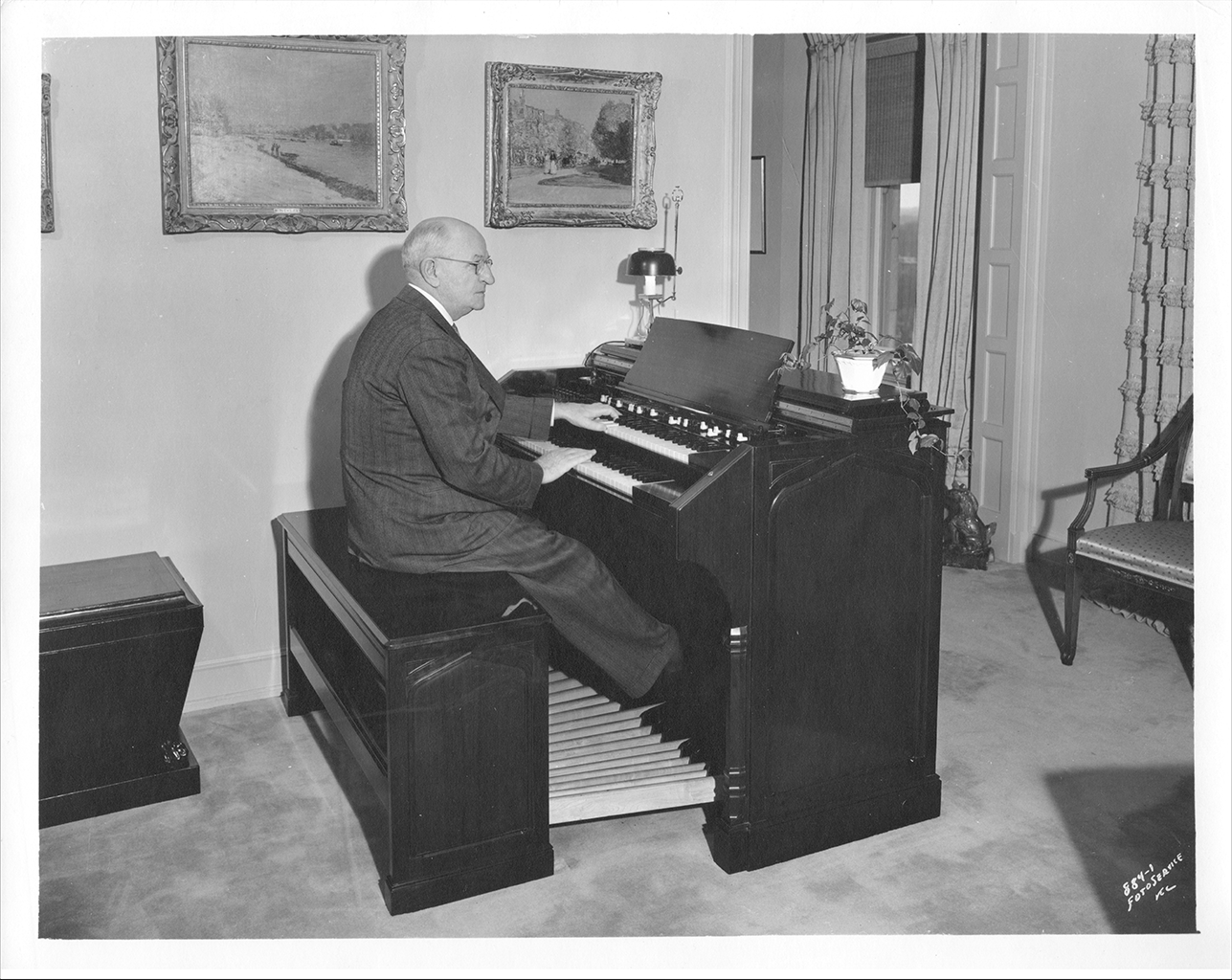
Notes
-
Caroline Durand-Ruel Godefroy, “Paul Durand-Ruel and Alfred Sisley: 1872–1895,” in MaryAnne Stevens, ed., Alfred Sisley, exh. cat. (London: Royal Academy of Arts, 1992), 36–38.
-
The Embankment at Billancourt—Snow is signed but undated. When the painting was first displayed at the Exposition Alfred Sisley, Galerie Georges Petit, Paris, February 5–28, 1897, it appeared as La Berge, à Billancourt, neige, 1879 in the exhibition catalogue. The same date is given for the picture in both catalogues raisonnés of Sisley’s work. See François Daulte, Alfred Sisley: Catalogue raisonné de l’œuvre peint (Lausanne: Éditions Durand-Ruel, 1959), no. 347, unpaginated; and Sylvie Brame and François Lorenceau, Alfred Sisley: Catalogue critique des peintures et des pastels (Lausanne: La Bibliothèque des arts, 2021), no. 376, p. 164. A Durand-Ruel label on the painting’s stretcher bears an alternative date of 1873, but the latter is almost certainly erroneous. Sisley is not known to have painted at Boulogne-Billancourt prior to 1877; see MaryAnne Stevens, independent scholar, to Brigid M. Boyle, NAMA, April 21, 2022, NAMA curatorial files. According to Flavie Durand-Ruel, incorrect dates of creation for artworks are not uncommon in Durand-Ruel’s records; see Flavie Durand-Ruel, Durand-Ruel et Cie, to Brigid M. Boyle, NAMA, April 19, 2022, NAMA curatorial files.
-
For Sisley’s other paintings of Boulogne-Billancourt, see Brame and Lorenceau, Alfred Sisley, nos. 267–76, 303, 305–10, 324, and possibly 380, pp. 127–29, 138–41, 147, and 165. Boulogne-Billancourt belongs to the so-called “belle boucle de la Seine” (beautiful loop of the Seine), an area extending from Issy-les-Moulineaux to Suresnes. It was so named by Albert Bezançon, one of the founders of Société historique de Boulogne-Billancourt. See Les peintres de la “belle boucle” de la Seine, 1800–1930, exh. cat. (Issy-les-Moulineaux, France: Musée Français de la Carte à Jouer de la Ville d’Issy-les-Moulineaux, 2015), 11.
-
Paris absorbed Auteuil and ten other communes in 1860. See Penel Beaufin, Histoire complète et Inédite, Religieuse, Politique, Sociale et Descriptive de Boulogne-Billancourt: Depuis les Origines jusqu’à nos Jours (Boulogne-sur-Seine: A. Doizelet, 1905), 2:264.
-
See Alexis Monnerot-Dumaine, “De Boulogne et Billancourt à Boulogne-Billancourt,” Le Village de Billancourt, September 27, 2020, https://levillagedebillancourt.fr
/2020 ; and Alexis Monnerot-Dumaine, “Quand Billancourt voulait devenir une commune indépendante,” Le Village de Billancourt, May 14, 2022, https://levillagedebillancourt.fr/09 /27 /de-boulogne-et-billancourt-a-boulogne-billancourt /2022 ./05 /14 /quand-billancourt-voulait-devenir-une-commune-independante -
Beaufin, Histoire complète et Inédite, 2:298.
-
Alphonse Le Gallo was a longtime mayor of Boulogne-Billancourt. I am indebted to Claude Colas, chef du service des Archives municipales de Boulogne-Billancourt, and Alexis Monnerot-Dumaine, author of the blog Le Village de Billancourt: Quand Billancourt était au milieu des champs (https://levillagedebillancourt.fr
/r ), for their help in identifying Sisley’s location. -
It is unknown when this house was constructed or demolished. The town cadastres (property registers) of 1860 and 1905 make no mention of a building at this site. Claude Colas, Archives municipales de Boulogne-Billancourt, to Brigid M. Boyle, NAMA, July 21, 2022, NAMA curatorial files.
-
Indeed, the Legrand port at the Alphonse Le Gallo quay is currently the focus of a major urban project. HAROPA PORT, the agency that oversees the ports of Le Havre, Rouen, and Paris, is redeveloping this site in 2022–23. Planned improvements include upgrades to existing port facilities, a new pedestrian side path, and better points of access for vehicles. See “Redevelopment of the Legrand port in Boulogne-Billancourt,” HAROPA PORT, April 5, 2022, https://www.haropaport.com
/en/paris ./redevelopment-legrand-port-boulogne-billancourt-92 -
See Daulte, Alfred Sisley, no. 348, unpaginated; and Brame and Lorenceau, Alfred Sisley, no. 380, p. 165. Daulte assigned the two paintings sequential numbers (the Nelson-Atkins work is no. 347), presumably in recognition of this resemblance.
-
For a concurring opinion, see Alexis Monnerot-Dumaine, independent scholar, to Brigid M. Boyle, NAMA, July 19, 2022, NAMA curatorial files. Another possibility is that the privately owned picture depicts Suresnes, a suburb just north of Boulogne-Billancourt on the left bank of the Seine. French businessman Léon Clapisson (1836–94), the painting’s first known owner, recorded its title as Un dégel (Suresnes) (A Thaw [Suresnes]) and its year of creation as 1880 in his notebook. See Anne Distel, “Appendix II: The Notebooks of Léon Clapisson,” in Colin B. Bailey, Renoir’s Portraits: Impressions of an Age, exh. cat. (New Haven: Yale University Press, 1997), 354. Whether this information is reliable is open to debate: at Clapisson’s posthumous sale, the work received a different title, Les Bords du Loing en hiver (The Banks of the Loing in Winter). See Catalogue de Tableaux modernes, Pastels, Aquarelles et Dessins; Tableaux et Dessins anciens; Composant la Collection de M. X*** (Paris: Hotel Drouot, April 18, 1894), 11. If the picture’s setting is indeed Suresnes, then Sisley surely had the Nelson-Atkins picture in mind when painting it.
-
For Clapisson’s life and career, see Anne Distel, “Léon Clapisson: Patron and Collector,” in Bailey, Renoir’s Portraits, 76–86.
-
The exhibitions in question were Exposition Alfred Sisley, Galerie Georges Petit, Paris, February 5–28, 1897; Exhibition: Paintings by Sisley (1840–1899), Durand-Ruel Galleries, New York, March 24–April 7, 1917; and Exhibition of Paintings by Alfred Sisley (1840–1899), Durand-Ruel Galleries, New York, January 8–22, 1921.
-
Montmirail, “Notes d’un badaud,” Le Gaulois, no. 5588 (February 20, 1897): 1. “Je ne saurais dire combien j’aime entre tous les impressionnistes ce délicat et simple Sisley qui expose chez Petit une partie de son œuvre. . . . Il ne souhaite que de faire revivre dans ses tableaux la sereine splendeur des ciels d’été, la mélancholie douloureuse des ciels d’automne, la douceur virginale des ciels de printemps, la morne tristesse des ciels d’hiver.” All translations are by Brigid M. Boyle.
-
“Exhibitions Now On: Sisley at Durand-Ruel’s,” American Art News 15, no. 25 (March 31, 1917): 2.
-
For accounts of Seachrest’s life, see Madeleine Johnston, “Penpoint Portraits of Kansas City Women: Effie Seachrest, Art Advisor,” Kansas City Star, November 3, 1929, 7C; Edward R. Schauffler, “Taking Up Art For Art’s Sake: It Became Her Life Work,” Kansas City Star, July 14, 1946, 4C; “Miss Effie Seachrest: The Art Connoisseur and Collector Dies at 83,” Kansas City Times, March 24, 1952, 8; Donald L. Hoffmann, “Effie Seachrest, a Little Lady Who Brought Great Art Here,” Kansas City Star, August 28, 1966, 1E; Daniel MacMorris, “Artist Adds a Word Picture of Effie Seachrest,” Kansas City Star, September 17, 1966, 16; and Homage to Effie Seachrest, exh. cat. (Kansas City, MO: Nelson Gallery-Atkins Museum, 1966), 5–7.
-
Seachrest purchased at least two other paintings by Sisley at unknown dates: The Dam at Saint-Mammès and Vieilles maisons (Old Houses). She lent the latter to the Nelson-Atkins in 1934. I thank MacKenzie Mallon, specialist, provenance, NAMA, for this information.
-
See “In Gallery and Studio,” Kansas City Star, April 4, 1931, E. This work was later deaccessioned. For Parsons, see MacKenzie Mallon, “Laying the Foundation: Harold Woodbury Parsons and the Making of an American Museum,” in Susan Bracken and Adriana Turpin, eds., Art Markets, Agents, and Collectors: Collecting Strategies in Europe and the United States, 1550–1950 (London: Bloomsbury Visual Arts, 2021), 306–15.
-
M[inna] K. P[owell], “In Gallery and Studio: News and Views of the Week in Art,” Kansas City Star, February 9, 1929, 6.
-
For example, Brace served lunch to Seachrest’s guests on December 1, 1942. See “Society,” Kansas City Times, December 1, 1942, 4.
-
No purchase invoice survives, but James Reuland, grandson of Mildred and William James Brace, believes they acquired The Embankment at Billancourt—Snow from Seachrest “well before 1950 (and I imagine also well before the 1942 event),” by which he means the luncheon Mildred Brace hosted in 1942 (see note 20). James Reuland to Brigid M. Boyle, NAMA, March 23, 2022, NAMA curatorial files.
-
I thank James and Terrence Reuland for sharing memories of their grandfather’s organ-playing. For more on the Braces, see their obituaries: “W. J. Brace is Dead: Former Gleaner Firm Head was 84,” Kansas City Times, August 30, 1960, 3; and “Mrs. Mildred Brace,” Kansas City Star, March 17, 1975, 5.
Technical Entry
Technical entry forthcoming.
Documentation
Citation
Chicago:
Brigid M. Boyle, “Alfred Sisley, The Embankment at Billancourt—Snow, ca. 1879,” documentation in French Paintings and Pastels, 1600–1945: The Collections of The Nelson-Atkins Museum of Art, ed. Aimee Marcereau DeGalan (Kansas City: The Nelson-Atkins Museum of Art, 2023), https://doi.org/10.37764/78973.5.660.4033.
MLA:
Boyle, Brigid M.. “Alfred Sisley, The Embankment at Billancourt—Snow, ca. 1879,” documentation. French Paintings and Pastels, 1600–1945: The Collections of The Nelson-Atkins Museum of Art, edited by Aimee Marcereau DeGalan, Nelson-Atkins Museum of Art, 2023. doi: 10.37764/78973.5.660.4033.
Provenance
Citation
Chicago:
Brigid M. Boyle, “Alfred Sisley, The Embankment at Billancourt—Snow, ca. 1879,” documentation in French Paintings and Pastels, 1600–1945: The Collections of The Nelson-Atkins Museum of Art, ed. Aimee Marcereau DeGalan (Kansas City: The Nelson-Atkins Museum of Art, 2023), https://doi.org/10.37764/78973.5.660.4033.
MLA:
Boyle, Brigid M.. “Alfred Sisley, The Embankment at Billancourt—Snow, ca. 1879,” documentation. French Paintings and Pastels, 1600–1945: The Collections of The Nelson-Atkins Museum of Art, edited by Aimee Marcereau DeGalan, Nelson-Atkins Museum of Art, 2023. doi: 10.37764/78973.5.660.4033.
With Gaston-Alexandre Camentron, Paris, by February 23, 1892;
Purchased from Camentron by Galeries Durand-Ruel, Paris, stock no. 2021, as La berge à Bellancourt, 1892–July 1897 [1];
Transferred from Galeries Durand-Ruel, Paris, to Durand-Ruel Galleries, New York, stock no. 1902, July 1897–March 16, 1927 [2];
Purchased from Durand-Ruel Galleries by Effie Seachrest, Kansas City, MO, 1927–no later than June 18, 1949 [3];
Purchased from Seachrest by Mr. William James (1875–1960) and Mrs. Mildred (née White, 1882–1975) Brace, Kansas City, MO, by 1949–March 31, 1975 [4];
Their bequest to The Nelson-Atkins Museum of Art, Kansas City, MO, 1975.
Notes
[1] See email from Paul-Louis Durand-Ruel and Flavie Durand-Ruel, Durand-Ruel et Cie., Paris, to Nicole Myers, NAMA, January 11, 2016, NAMA curatorial files. A handwritten inscription and paper label on the stretcher corroborate the stock number.
[2] See email from Paul-Louis Durand-Ruel and Flavie Durand-Ruel, Durand-Ruel et Cie., Paris, to Nicole Myers, NAMA, January 11, 2016, NAMA curatorial files. A handwritten inscription and paper label on the stretcher corroborate the stock number. See also the Durand-Ruel photo stock card, National Gallery of Art, Washington, DC, Photo Archives, no. A184.
[3] See email from Paul-Louis Durand-Ruel and Flavie Durand-Ruel, Durand-Ruel et Cie., Paris, to Nicole Myers, NAMA, January 11, 2016, NAMA curatorial files. Effie Seachrest (1869–1952) was a Kansas City dealer and connoisseur of modern art who went on frequent scouting trips to New York and Europe. She organized exhibitions and hosted art appreciation classes at her home on Troostwood Road, known as the Little Gallery in the Woods. Seachrest sold The Embankment at Billancourt—Snow to William James and Mildred Brace sometime prior to June 18, 1949, when the Braces had the painting cleaned by Nelson-Atkins conservator James Roth; see Nelson-Atkins deposit receipt dated June 18, 1949, NAMA curatorial files. The precise date of sale is unknown, but extant correspondence confirms that Seachrest placed the painting in the Brace collection; see letter from Ralph T. Coe, NAMA, to Mildred Brace, June 9, 1966, NAMA archives. James Reuland, grandson of William James and Mildred Brace, believes his grandparents acquired The Embankment at Billancourt—Snow “well before” Seachrest’s passing in 1952. See email from James Reuland to Brigid M. Boyle, NAMA, March 23, 2022, NAMA curatorial files.
[4] When Mildred Brace died on March 16, 1975, she bequeathed Sisley’s The Embankment at Billancourt—Snow to the Nelson-Atkins but stipulated that her daughter, Betty Jane Reuland (née Brace, 1916–2002), retain the work during her lifetime. Reuland displayed the painting at her home in Kansas City until her death on March 10, 2002, after which it was transferred to the Nelson-Atkins. See email from James Reuland, grandson of William James and Mildred Brace, to Brigid M. Boyle, NAMA, March 23, 2022.
Related Works
Citation
Chicago:
Brigid M. Boyle, “Alfred Sisley, The Embankment at Billancourt—Snow, ca. 1879,” documentation in French Paintings and Pastels, 1600–1945: The Collections of The Nelson-Atkins Museum of Art, ed. Aimee Marcereau DeGalan (Kansas City: The Nelson-Atkins Museum of Art, 2023), https://doi.org/10.37764/78973.5.660.4033.
MLA:
Boyle, Brigid M.. “Alfred Sisley, The Embankment at Billancourt—Snow, ca. 1879,” documentation. French Paintings and Pastels, 1600–1945: The Collections of The Nelson-Atkins Museum of Art, edited by Aimee Marcereau DeGalan, Nelson-Atkins Museum of Art, 2023. doi: 10.37764/78973.5.660.4033.
Possibly Alfred Sisley, The Banks of the Seine in Winter, ca. 1879, oil on canvas, 18 1/8 x 21 5/8 in. (46 x 55 cm), private collection; cited in Sylvie Brame and François Lorenceau, Alfred Sisley: Catalogue critique des peintures et des pastels (Lausanne: La Bibliothèque des arts, 2021), no. 380, p. 165.
Exhibitions
Citation
Chicago:
Brigid M. Boyle, “Alfred Sisley, The Embankment at Billancourt—Snow, ca. 1879,” documentation in French Paintings and Pastels, 1600–1945: The Collections of The Nelson-Atkins Museum of Art, ed. Aimee Marcereau DeGalan (Kansas City: The Nelson-Atkins Museum of Art, 2023), https://doi.org/10.37764/78973.5.660.4033.
MLA:
Boyle, Brigid M.. “Alfred Sisley, The Embankment at Billancourt—Snow, ca. 1879,” documentation. French Paintings and Pastels, 1600–1945: The Collections of The Nelson-Atkins Museum of Art, edited by Aimee Marcereau DeGalan, Nelson-Atkins Museum of Art, 2023. doi: 10.37764/78973.5.660.4033.
Exposition Alfred Sisley, Galerie Georges Petit, Paris, February 5–28, 1897, no. 7, as La Berge, à Billancourt, neige, 1879.
Exhibition: Paintings by Sisley (1840–1899), Durand-Ruel Galleries, New York, March 24–April 7, 1917, no. 1, as La berge à Billancourt.
Exhibition of Paintings by Alfred Sisley (1840–1899), Durand-Ruel Galleries, New York, January 8–22, 1921, no. 12, as La berge à Billancourt.
Exhibition of Paintings by Camille Pissarro and Alfred Sisley, Durand-Ruel Galleries, New York, February 18–March 1925, no. 19, La berge à Billancourt.
Kansas City Collects: A Selection of Works of Art Privately Owned in the Greater Kansas City Area, The Nelson-Atkins Museum of Art, Kansas City, MO, January 22–February 28, 1965, no. 17, as The Embankment at Billancourt, Snow.
Homage to Effie Seachrest, The Nelson-Atkins Museum of Art, Kansas City, MO, August 25–October 9, 1966, no. 4, as The Embankment at Brillancourt [sic]—Snow.
Gli Impressionisti e la neve: La Francia e l’Europa, Palazzina della Promotrice delle Belle Arti, Turin, Italy, November 27, 2004–April 25, 2005, no. 125, as L’argine a Billancourt, neve.
References
Citation
Chicago:
Brigid M. Boyle, “Alfred Sisley, The Embankment at Billancourt—Snow, ca. 1879,” documentation in French Paintings and Pastels, 1600–1945: The Collections of The Nelson-Atkins Museum of Art, ed. Aimee Marcereau DeGalan (Kansas City: The Nelson-Atkins Museum of Art, 2023), https://doi.org/10.37764/78973.5.660.4033.
MLA:
Boyle, Brigid M.. “Alfred Sisley, The Embankment at Billancourt—Snow, ca. 1879,” documentation. French Paintings and Pastels, 1600–1945: The Collections of The Nelson-Atkins Museum of Art, edited by Aimee Marcereau DeGalan, Nelson-Atkins Museum of Art, 2023. doi: 10.37764/78973.5.660.4033.
Exposition Alfred Sisley, exh. cat. (Paris: Galerie Georges Petit, 1897), 26 [repr., in Theodore Reff, ed., Modern Art in Paris: Two-Hundred Catalogues of the Major Exhibitions Reproduced in Facsimile in Forty-Seven Volumes, vol. 43, Exhibitions of Impressionist Art I (New York: Garland, 1981), unpaginated], as La Berge, à Billancourt, neige, 1879.
Exhibition: Paintings by Sisley (1840–1899), exh. cat. (New York: Durand-Ruel Galleries, 1917), unpaginated, as La berge à Billancourt.
“Exhibitions Now On: Sisley at Durand-Ruel’s,” American Art News 15, no. 25 (March 31, 1917): 2.
Exhibition of Paintings by Alfred Sisley (1840–1899), exh. cat. (New York: Durand-Ruel Galleries, 1921), unpaginated, as La berge à Billancourt.
“Sisley at Durand-Ruel’s,” American Art News 19, no. 14 (January 15, 1921): 2, as Berge a [sic] Billancourt.
Exhibition of Paintings by Camille Pissarro and Alfred Sisley, exh. cat. (New York: Durand-Ruel Galleries, 1925), unpaginated, as La berge à Billancourt.
Possibly M[inna] K. P[owell], “In Gallery and Studio: News and Views of the Week in Art,” Kansas City Star 49, no. 131 (January 26, 1929): 6.
Possibly M[inna] K. P[owell], “In Gallery and Studio: News and Views of the Week in Art,” Kansas City Star 49, no. 145 (February 9, 1929): 6.
Possibly M[inna] K. P[owell], “Art: Centuries of Paintings at the Kansas City Art Institute Draw Large Crowd,” Kansas City Times 98, no. 6 (January 7, 1935): 13.
François Daulte, Alfred Sisley: Catalogue raisonné de l’œuvre peint (Lausanne: Éditions Durand-Ruel, 1959), no. 347, pp. 345, 351, 358, (repro.), as La Berge à Billancourt en 1879—neige.
Kansas City Collects: A Selection of Works of Art Privately Owned in the Greater Kansas City Area, exh. cat. (Kansas City: Nelson Gallery and Atkins Museum, 1965), unpaginated, as The Embankment at Billancourt, Snow.
Ralph T. Coe, “Fine Art in Growing Private Collections Here,” Kansas City Times 97, no. 135 (February 11, 1965): 12D.
Homage to Effie Seachrest, exh. cat. ([Kansas City, MO]: Nelson Gallery-Atkins Museum, 1966), 7, 13, 15, (repro.), as The Embankment at Brillancourt [sic]—Snow.
“Homage to Effie Seachrest,” Gallery Events (The William Rockhill Nelson Gallery of Art and Mary Atkins Museum of Fine Arts) (July–August 1966): unpaginated.
“Recent Acquisitions,” Bulletin (The Nelson Gallery and Atkins Museum) 5, no. 3 (February 1976): 39, (repro.), as The Embankment at Billancourt—Snow.
MaryAnne Stevens, ed., Alfred Sisley, exh. cat. (London: Royal Academy of Arts, 1992), 53n105, 178, 279.
Charles S. Moffett et al., Impressionists in Winter: Effets de Neige, exh. cat. (Washington, DC: Phillips Collection, 1998), 77n19.
Marco Goldin, Gli impressionisti e la neve: La Francia e l’Europa, exh. cat. (Conegliano, Italy: Linea d’ombra Libri, 2004), 295, 384, (repro.), as L’argine a Billancourt, neve.
Léonard Gianadda and Martha Degiacomi, Trésors impressionnistes: La Collection Ordrupgaard; Degas, Cézanne, Monet, Renoir, Gauguin, Matisse . . ., exh. cat. (Geneva: Fondation Pierre Gianadda, 2019), 62, 62n1.
Sylvie Brame and François Lorenceau, Alfred Sisley: Catalogue critique des peintures et des pastels (Lausanne: La Bibliothèque des arts, 2021), no. 376, pp. 164, 450, 516–17, 519, 522, 550, (repro.), as La berge à Billancourt, temps de neige.
